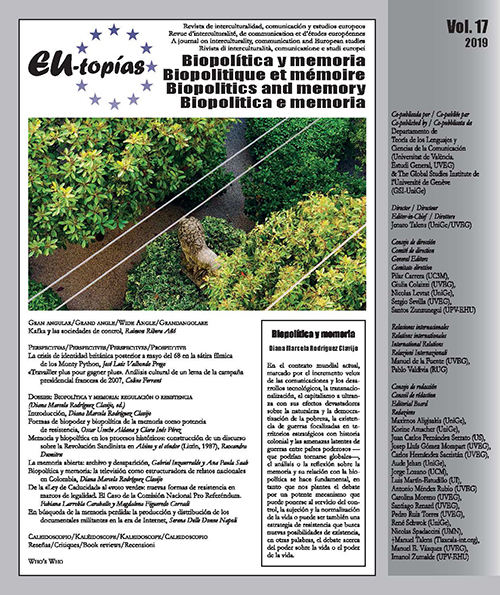Forms of Biopower and Biopolitics of Memory as Power of Resistance
DOI:
https://doi.org/10.7203/eutopias.0.18321Keywords:
Power, power as a relation of forces, bios/zoé, biopower, biopolitics, resistance, minority memories Abstract
Abstract
The article addresses the questions of power over life (biopower) and resistance that emerge from/in life (biopolitics). It provides an exploration of the forms of administration of the living on the part of central powers together with an explanation of the traits of the totalitarian becoming of biopower, and of the emergence of the bio-economic problem as a specific field pretending the ecosystem of life (zoé) to work within the limits of the linear and closed systems of market and capital. On the other hand, following Spinoza, and his lesson about the turning of potency into power, indications are provided about how resistance can open up the possibility for a politics of life as immanent force, one allowing the foundation of processes of emancipation. Minority memories and memories of resistance would work in such direction, encouraging autonomous circuits for the production of social subjectivity
 Downloads
Downloads
 References
References
AGAMBEN, Giorgio (1996), La comunidad que viene. Valen- cia: Pre-Textos.
— (2001), Medios sin fin. Notas sobre la política. Valencia: Pre-Textos.
— (2003), Estado de excepción. Homo sacer II, 1. Valencia: Pre-Textos.
BOHM, David (1992), La totalidad y el orden implicado. Bar- celona: Kairos.
BRAIDOTTI, Rosi (2015), Lo posthumano. Barcelona: Gedisa — (2009), Transposiciones. Sobre la ética nómada. Barcelona: Gedisa
CASTRO, Edgardo (2008), «Biopolítica: De la Soberanía al Gobierno», Revista Latinoamericana de Filosofía, vol. XXXIV, n.o 2.
DELEUZE, Gilles (2014), El poder. Curso sobre Foucault. Buenos Aires: Cactus.
— (1986). Foucault. Paris: Minuit.
— (1995), «Post-scriptum sobre las sociedades de control». En Conversaciones, Valencia: Pretextos.
— (2001), Spinoza, Filosofía práctica. Barcelona: Tusquets.
— (2008), En medio de Spinoza. Buenos Aires: Cactus. FOUCAULT, Michel (1975), Surveiller et punir. Paris: Gallimard.
— (1975), Vigilar y castigar. Nacimiento de la prisión. Ma- drid: Siglo XXI.
— (1988). Nietzsche, la genealogía, la historia. Valencia: Pre-Textos.
— (2002), Defender la sociedad. México: Fondo de Cultura Económica.
— (2004), Nacimiento de la biopolítica. Madrid: Ediciones Akal.
— (2006), Seguridad, territorio, población. Buenos Aires: Fondo de Cultura Económica.
— (2009), Historia de la sexualidad 1. La voluntad de saber. Buenos Aires: Siglo XXI
FUMAGALLI, Andrea (2010), Bioeconomía y capitalismo cognitivo. Madrid: Traficantes de sueños.
GUATTARI, Félix (1996), Las tres ecologías. Valencia: Pre-Textos.
HARAWAY, Donna (1984). «A Manifesto for Cyborgs». Socialist Review.
HARDT, Michael; NEGRI, Antonio (2009), Common Wealth. El proyecto de una revolución del común. Madrid: Akal.
JESSOP, Bob (1999). La crisis del Estado de Bienestar. Hacia una teoría del estado y consecuencias sociales. Bogotá, Siglo del Hombre editores.
MARGULIS, Lynn y SAGAN, Doron (1996), ¿Qué es la vida? Barcelona: Tusquets.
— (2005). Microcosmos. Barcelona: Tusquets.
MATURANA, Humberto; VARELA, Francisco (2003), De Máquinas y seres vivos. Buenos Aires: Lumen: Editorial Universitaria.
MORIN, Edgar (2003), El método V. La humanidad de la humanidad. Madrid: Cátedra.
NIETZSCHE, Friederich (2001), La filosofía en la época trágica de los griegos. Madrid: Valdemar.
SCHRÖDINGER, Erwin (1988), ¿Qué es la vida? Barcelona: Tusquets.
SPINOZA, Baruj (2002), Ética demostrada según el orden
geométrico. México: Fondo de Cultura Económica. PASSET, René (1996), Principios de bioeconomía. Madrid: Fundación Argentaria.
VIRILIO, Paul (1995). La velocidad de liberación. Buenos Aires: Manantial.
Downloads
Published
How to Cite
-
Abstract528
-
PDF (Español)182
Issue
Section
License
![]()
The authors conserve the copyright. All content published in EU-topías. Journal of interculturality, Communication, and European Studies are subject to the license Creative Commons Attribution-NonCommercial-ShareAlike 4.0 license. The full text of the license can be found at <http://creativecommons.org/licenses/by-nc-sa/4.0>
They may be copied, used, disseminated, transmitted and publicly displayed, provided that:
- The authorship and original source of the publication is cited (journal, publisher and URL of the work).
- They are not used for commercial purposes.
- The existence and specifications of this license of use are mentioned.
It is the responsibility of the authors to obtain the necessary permissions for images that are subject to copyright.



